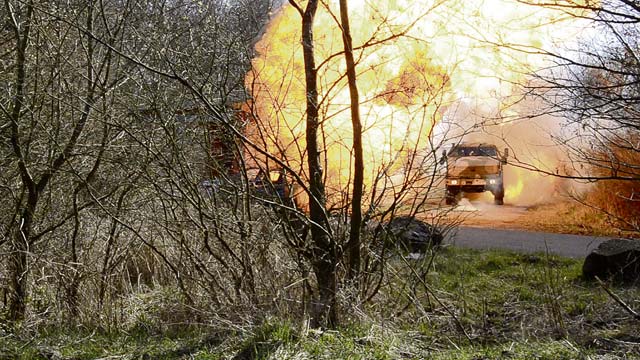
A German tactical vehicle pushes through a fireball during a training exercise March 27 on Baumholder’s military training area.
American and German soldiers teamed up on Baumholder’s Military Training Area March 24 to 27 to hone their tactics, techniques and procedures associated with convoy operations.
With a German SWAT team providing all the explosions and smoke, members of the 421st Multifunctional Medical Battalion, 30th Medical Brigade and the 950th Bundeswehr Tactical Psychological Operations unit ran the gauntlet of force protection procedures in a convoy environment. For four days, both armies faced and reacted to everything from simulated improvised explosive device explosions to sniper fire as they conducted convoys on Baumholder’s
MTA.
“We were working alongside the German forces, learning their tactics as far as reacting to IEDs or incoming fire, indirect and direct,” said Pfc. Noah Speers, health care specialist assigned to the 421st Multifunctional Medical Battalion, 30th Medical Brigade.
Working alongside German soldiers, the American Soldiers learned there is more than one way to achieve an objective.
“The way the German forces react to getting out of a vehicle is different from what I’ve ever been taught. They stack on the vehicle differently and have different positions when stacked on the vehicle as far as where every person goes, what order they get out, how they get out and the firing positions they’re at when they get out. It’s all very organized and very disciplined,” Speers said. “It helps put what we learned into perspective, and it gives you a different idea of how tactics can be altered, and it gives you ideas on how you can better yourself as a Soldier.”
Sgt. Maran Shaker, team leader, also assigned to the 421st MMB, 30th Medical Brigade, agreed that training with foreign armies reaps benefits for everyone involved.
“I enjoyed it very much. I think I gained a lot of experience from it. The types of teams that we were training with are more specialized toward psychological operations, therefore their tactics were targeted more toward their goal and the types of missions they carry out. It’s also very different from what we do in general, so it was a new experience to see how they did things. It was more targeted toward going in, talking to the villagers and things like that,” Shaker said.
Their German counterpart, Andreas Kremer, who was a vehicle commander and second patrol leader during the four-day exercise, echoed the comments of Shaker and Speers.
“The training today had very complex situations, and it was very impressive to see how well we can work together just after a few days. It was great. There was great (camaraderie) within our team. The whole training was successful, because we worked together as a team from the first day to the last day. We saw that all the training we did together works. So we can make sure that when we go on foreign missions with our American friends we can do a good job together,” Kremer said.
Shaker summed up the four days of training by pointing out the benefits of training as a multinational force.
“That we are stationed in Germany is an excellent opportunity for many Soldiers to encounter different types of military training. Training together with other armies gives us a different perspective on how they view the same missions. Being that we have joint missions downrange now, this training gives us the experience we need to work with foreign nation armies during deployments. I think it’s an excellent opportunity. We develop a lot of bonds on the personal level and on the professional level as well,” Shaker said.


